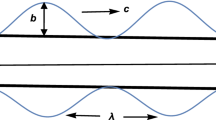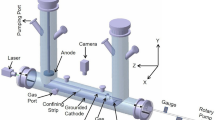Abstract
WITH the view of making accurate measurements of the velocity of sound, and hence of the ratio of the two principal specific heats of gases, we have been studying the formation of dust figures in a sounding tube. Instead of using a stroked rod to produce the vibrations of known frequency, as Kundt did in the form of experiment known by his name, we employ a telephone diaphragm (actually a loud-speaker unit) excited by a current of approximately pure sine-wave form, which is produced by a suitable valve circuit. The frequency of the vibration is then varied until one of the resonant frequencies of the tube is reached, when the dust phenomena are produced with great distinctness and can be studied at leisure.
This is a preview of subscription content, access via your institution
Access options
Subscribe to this journal
Receive 51 print issues and online access
$199.00 per year
only $3.90 per issue
Buy this article
- Purchase on Springer Link
- Instant access to full article PDF
Prices may be subject to local taxes which are calculated during checkout
Similar content being viewed by others
Author information
Authors and Affiliations
Rights and permissions
About this article
Cite this article
DA C. ANDRADE, E., LEWER, S. New Phenonema in a Sounding Dust Tube. Nature 124, 724–725 (1929). https://doi.org/10.1038/124724a0
Issue Date:
DOI: https://doi.org/10.1038/124724a0
This article is cited by
-
Sedimentation of harmful dust by means of ultrasonic waves and additional disperse phase
Arabian Journal of Geosciences (2015)
Comments
By submitting a comment you agree to abide by our Terms and Community Guidelines. If you find something abusive or that does not comply with our terms or guidelines please flag it as inappropriate.



